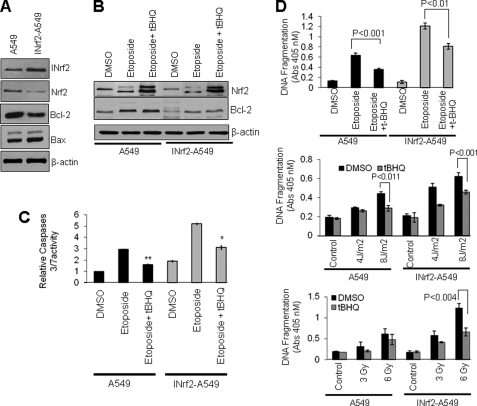FIGURE 8.
Dysfunctional INrf2 stabilized Nrf2 and Bcl-2, leading to reduced etoposide and UV/γ radiation-mediated DNA fragmentation in non-small cell lung cancer A549 cells. A, A549 cells expressing mutant INrf2 and cDNA-derived wild type INrf2 (INrf2-A549) were immunoblotted with anti-Nrf2, -INrf2, -Bcl-2, -Bax, and -actin antibodies. B, A549 or INrf2-A549 cells were treated with DMSO, 10 μm etoposide, or etoposide + t-BHQ. The endogenous levels of Nrf2 and Bcl-2 were analyzed by Western blotting. C, the same cell lysates (20 μg) were mixed with Caspase-Glo 3/7 substrate (Promega), and caspase 3/7 activity was measured. D, 5000 A549 or INrf2-A549 cells were plated in 24-well plates (in triplicates) and treated with DMSO or the indicted concentrations of etoposide for 48 h. One set of cells was further treated with t-BHQ (50 μm) for an additional 24 h (upper panel), irradiated with UVB light (middle panel), or irradiated with the indicated grays (Gy) of γ radiation (lower panel). The cells were incubated for 24 h, post-treated with DMSO or t-BHQ for an additional 24 h, and harvested. The cytoplasmic histone-associated DNA fragments (mono- and oligonucleosomes) were quantified using a Cell Death Detection ELISA kit (Roche Applied Science) and plotted. The experiments were repeated three times. The data represented are the mean ± S.D. from three independent experiments (*, p < 0.05; **, p < 0.005). Error bars indicate S.E. of triplicate samples.

